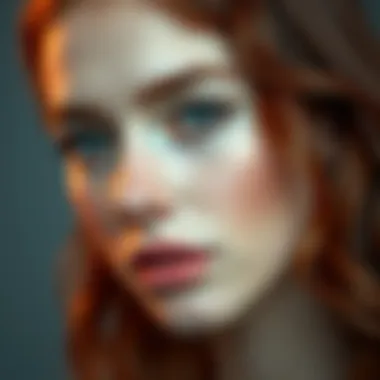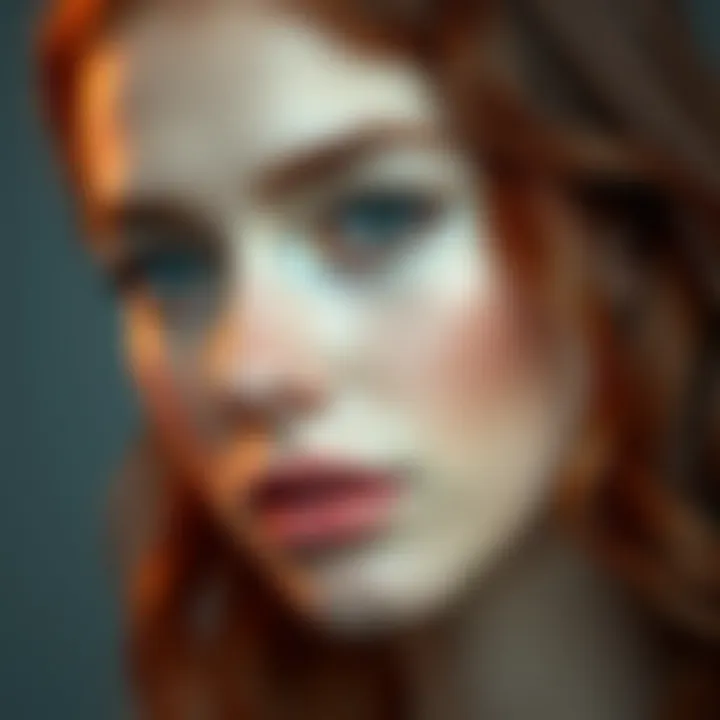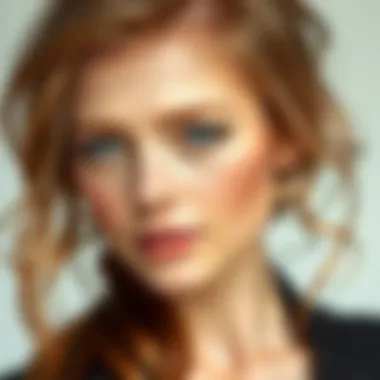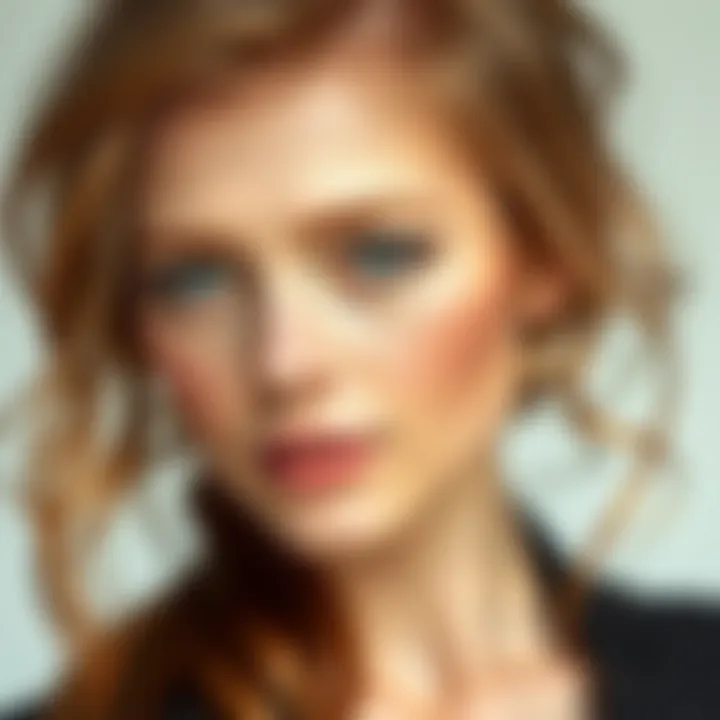Best Hair Colors for Red Skin Tones and Blue Eyes


Intro
Selecting the right hair color is not just a matter of aesthetics; it’s an opportunity to express individuality and enhance one's natural beauty. For women with red skin tones and blue eyes, the task can seem particularly daunting. When you think about it, the intersection of these characteristics can create a unique canvas ripe for exploration.
Understanding how your skin tone interacts with hair colors can transform a standard look into a striking harmony that catches the eye. This article is designed to guide you through the multifaceted journey of choosing the perfect hair color tailored to your distinct features. We will break down the key concepts of color theory, dive into the significance of undertones, and provide actionable beauty tips, all while keeping in mind the essence of personal style.
As we venture through this guide, you might find that the right color doesn’t always follow conventional wisdom. Sometimes, it’s about finding what resonates with you personally, creating a look that feels undeniably authentic. If you’re ready to embark on this colorful adventure, let’s get those creative juices flowing!
"The colors you choose are not just a reflection of your style; they tell a story about who you are."
Next, we’ll explore some of the Key Trends in beauty and fashion that align beautifully with red skin tones and blue eyes.
Understanding Skin Undertones
Understanding skin undertones is a crucial aspect in choosing the right hair color, especially for those with red skin tones and blue eyes. This consideration is like the secret sauce that turns an ordinary look into something striking. When you have red undertones, recognizing this can save you from hair colors that clash rather than complement your natural hues. It’s not just about picking a shade off the color wheel; it’s about harmony.
Defining Undertones
Undertones are the subtle hues beneath the surface of our skin that affect how colors appear when we wear them. They can broadly be classified into three categories: cool, warm, and neutral. For individuals with red skin tones, warm undertones often prevail, giving the complexion a hint of pink or peach, or even a more fiery red.
When defining these undertones, one common method is the wrist test—checking the color of the veins. If your veins appear blue, you likely have cool undertones, while greenish veins can indicate warm undertones. However, red skin tones can sometimes complicate this, as they often are a blend, leaning towards warm even if it may not seem initially obvious.
Identifying Red Skin Tones
Identifying red skin tones requires a careful eye. For some, the redness may be more pronounced due to conditions like rosacea or simply a fair complexion that flushes easily. Distinguishing this can be tricky but crucial. If your skin consistently appears more red rather than beige or brown in natural light, it’s a solid sign you fall into this category.
Here are a few traits often associated with red skin tones:
- Visible redness, especially on the cheeks and nose.
- Difficulties in finding a matching foundation shade due to the undertones.
- An easily noticeable flush when exposed to heat or emotion.
The Importance of Undertones in Hair Color Selection
Understanding your undertones can be the difference between a hair color that elevates your features and one that makes you appear washed out. Choosing a hair color that aligns with your skin tone ensures that you enhance, rather than obscure, your natural beauty.
For instance, if you have red skin tones, opting for hair colors that incorporate warm shades—like rich auburns or golden blondes—can create a cohesive look. Cool tones, such as ash browns or platinum blondes, may clash and draw attention to unwanted redness rather than complementing it. This relationship is a significant factor: the right color boosts confidence and reflects personality.
Moreover, for women of all ages exploring color, acknowledging these subtleties opens up a world of possibilities. It transforms a seemingly simple decision into a journey of self-expression, where understanding oneself leads to feeling empowered in one's appearance.
The choice of hair color is not merely a styling decision; it's a reflection of self-identity, and understanding undertones plays a pivotal role in this process.
The Color Wheel and Its Relevance
Understanding the color wheel is essential for anyone navigating the intricate world of hair coloring, especially when it comes to selecting shades that complement red skin tones and blue eyes. The color wheel serves not merely as a tool, but rather as a guide to grasp how different colors interact with each other. This understanding is crucial for making informed choices that will enhance one’s natural beauty and create a harmonious appearance.
Basics of Color Theory
At its core, color theory is the study of how colors relate to one another and how they can affect the human eye. The wheel consists of primary, secondary, and tertiary colors.
- Primary Colors: These are the building blocks: red, blue, and yellow.
- Secondary Colors: Formed by mixing primary colors, such as green (blue + yellow) or orange (red + yellow).
- Tertiary Colors: These colors arise through the mixing of primary and secondary colors.
For individuals with red skin tones, understanding this wheel becomes critical. Since red is a primary color on the wheel, it tends to dominate the palette. Neutralizing this hue can be key to finding a complementary hair color. Using the wheel, one can see that various shades on the opposite side can create balance; thus, selecting hues that range from medium blues to purples can help counteract the redness in the skin.
Complementary Colors for Red Undertones
When addressing red undertones, a strategic approach involves identifying colors that complement rather than clash. Complementary colors sit opposite each other on the color wheel. For instance, greens and blues—situated directly across from red—can act as soothing agents for vibrant red skin tones.
Consider the following:
- Cool Tones: Shades of blue, from cobalt to navy, can beautifully offset red undertones. These colors are harmonious with blue eyes, creating an appealing synergy.
- Deep Greens: Not just any green will do. Look for richer tones like emerald, which can draw attention to the skin without overwhelming it.
- Lavender and Purple Hues: These shades can provide a soft balance to red tones, enhancing the natural glow of blue eyes while softening the overall look.
Choosing hair colors in these complementary shades will not only balance the warmth of red skin tones but will also make blue eyes pop, creating an overall striking appearance.


"Color is a power which directly influences the soul." – Wassily Kandinsky
In summary, awareness of the color wheel and the complementary color theory can immensely aid in deciding the most flattering hair colors. This understanding ensures that any choices made will resonate with one’s natural coloring, enhancing rather than detracting from one's features.
Best Hair Colors for Red Skin Tones
Selecting the right hair color for individuals with red skin tones can be quite the undertaking. It’s not just about personal preference, but also about harmonizing one’s coloring to enhance overall appearance. When you're sporting those striking blue eyes, the stakes are even higher. The right shade can elevate your natural beauty and showcase your unique features.
Hair color isn't merely a trend; it's a statement about who you are. Some colors can accentuate the warmth of red undertones, while others work to soften and contrast. In this section, we'll explore an array of hues that are particularly flattering, including warm colors like copper and golden blondes, cool shades such as platinum and ash brown, and even experimental colors. Each category boasts unique attributes that cater to different preferences and styles.
Warm Hair Colors
Copper Shades
Copper shades are often celebrated for their vibrant glow. This particular color strikes a fine balance—it radiates warmth and complements red undertones seamlessly. The fiery essence of copper not only brings out the blush in your cheeks but also dances beautifully alongside those blue eyes.
The key characteristic of copper is its ability to infuse life into otherwise dull appearances. Its warmth can create an inviting aura, making it a favorite choice for those looking to stand out. However, one must consider the maintenance. This hue tends to fade quicker than more neutral colors, often requiring regular touch-ups. Still, many find the vibrant depth worth the effort.
Golden Blondes
Moving onto golden blondes, this shade offers a touch of sun-kissed elegance. Golden blonde hair can enhance the brightness of blue eyes while providing a stunning contrast to red skin tones. The key here is the warmth; golden shades carry a richness that doesn’t clash but rather complements beautifully.
A unique feature about golden blondes is how they reflect light, creating a multi-dimensional effect. They also manage to add an air of sophistication. On the flip side, achieving this color often requires a skilled colorist to avoid unwanted brassy tones, which could detract from the overall look.
Rich Auburns
Rich auburn is a favorite among those aiming for depth without losing warmth. This color possesses a great balance, lending an earthy quality that appeals to many. It wonderfully highlights blue eyes while allowing for a seamless blend with red skin tones—ideal for those seeking a natural look.
The advantage of rich auburn lies in its versatility. It can be styled to fit both casual and formal occasions. However, some may find that it needs consistent upkeep, especially in maintaining that rich, luscious appearance.
Highlighting Techniques for Red Skin Tones
When it comes to selecting the ideal hair color for red skin tones, highlighting techniques can play a pivotal role. Not only do they add dimension and depth to the hair, but they also enhance the natural features of individuals with this specific skin hue. Red skin tones can often be sensitive, making the right hair color choices crucial to achieving a harmonious look.
Balayage for Depth
Balayage has become a buzzword in the beauty world for a good reason. This freehand coloring technique allows for a natural-looking transition between colors. It works particularly well for those with red skin tones, as it creates soft highlights that can blend seamlessly. Balayage is excellent for those who prefer low-maintenance styles since the growth of hair is less noticeable compared to traditional highlights.
- Benefits of Balayage:
- Adds depth and dimension to hair.
- Allows for a personalized approach, as colorists can adjust tones to suit individual tones.
- Creates a sun-kissed effect that complements blue eyes beautifully.
The magic of balayage lies in its versatility. Whether you want to add a hint of honey or go for more dramatic caramel highlights, the options are endless. This method is also great at softening the complexion and making blue eyes pop. With the right choice of shades—think warm golden tones or cool honey undertones—balayage can elevate your overall look, ensuring that your hair color works in tandem with your skin tone.
Foil Highlights vs. Ombre
Foil highlights and ombre are two popular techniques, both offering unique advantages for red skin tones. Understanding the difference—along with the outcomes of each—can help in making an informed choice.
- Foil Highlights:
- Ombre:
- This technique involves sectioning the hair and wrapping specific strands in foil before applying color.
- It provides a more pronounced and uniform color, which can be perfect for those looking to add striking contrast.
- Ombre creates a gradual transition from darker roots to lighter ends.
- This can look particularly stunning on red skin tones, giving an edgy yet sophisticated vibe.
"Choosing between foil highlights and ombre depends on the look you wish to achieve. Foil highlights suit those who desire a burst of brightness, while ombre works for softer, elongated transitions."
When considering which technique to go for, think about your lifestyle and the amount of upkeep you’re willing to commit to. Foil highlights may require more regular touch-ups due to their defined nature, while ombre can allow for a more natural regrowth look.
Color Maintenance for Red Skin Tones
Maintaining the vibrancy and health of hair color is crucial, particularly for those with red skin tones. Having the right hair color can enhance one's features and boost self-confidence, yet the investment in hair can easily go to waste if not properly cared for. When hair colors are chosen, especially on red skin tones, they need regular upkeep to maintain their aesthetic appeal. This section delves into significant aspects of color maintenance that are essential for individuals with red skin tones.
Choosing the Right Shampoo and Conditioner


Selecting the right shampoo and conditioner isn’t just about preference; it’s about ensuring the longevity of your hair color. For those with red skin tones, look for products specifically formulated for colored hair. Sulfate-free shampoos are a good bet since they are less harsh and help prevent premature color fading.
Avoid products that contain alcohol, as they can dry out your hair and lead to further color loss.
When it comes to conditioners, those enriched with moisturizing properties serve best. Ingredients like argan oil or shea butter add essential hydration, making the hair more manageable and less prone to damage.
Here are a few tips for choosing shampoos and conditioners:
- Opt for Color-Safe Shampoos: Look for labels that declare they protect hair color.
- Choose Hydrating Conditioners: Since red hair can be prone to dryness, a good conditioner can rescue it.
- Consider the pH balance: Products with a balanced pH level help keep the hair smooth and shiny.
Frequency of Touch-ups
Keeping color fresh and impressive often requires a game plan regarding touch-ups. Knowing when to schedule these maintenance appointments can significantly impact the overall look. For individuals with red skin tones, typically, touch-ups should be considered every 4 to 6 weeks, depending on the hair growth rate and the vibrancy of the color.
Factors to think about:
- Hair Growth: If your hair grows quickly, you might need to touch up sooner.
- Color Choice: Vibrant colors often need attention more frequently than subdued shades.
- Fading: Noticeable fading may occur sooner for red tones due to their vivid nature, so keeping an eye on maintenance is key.
"Regular touch-ups not only maintain color vibrancy but also promote healthier hair by reducing damage and split ends."
The Role of Eye Color in Hair Color Selection
When it comes to selecting hair color, eye color is often overlooked but it shouldn’t be. It plays a significant role in enhancing one’s overall look, especially for those with red skin tones and blue eyes. The way your hair color interacts with your eye color can amplify your natural features, either creating a striking contrast or a harmonious blend. Specifically, for blue-eyed individuals, there are two distinct approaches: contrasting colors and synergistic shades. Each technique has its own charm and can dramatically influence the final outcome of your look.
Complementing Blue Eyes
Contrasting Colors
Choosing a hair color that contrasts with blue eyes can create a visually stunning effect. The key characteristic of contrasting colors is their ability to make your blue peepers pop. By opting for shades like rich auburn, dark chocolate, or jet black, you draw attention to your eyes in a way that lighter or similar tones might not. This is a beneficial approach because the stark difference often highlights not just the color but also the depth of your eyes.
One unique feature of this technique is its versatility. Darker shades provide a bold statement, and they can establish a dramatic presence. However, keep in mind that these colors can require more maintenance, especially if you are naturally light-haired. The contrast can fade over time, and consistent touch-ups may be needed to keep that eye-catching effect intact.
Synergistic Shades
On the flip side, synergistic shades present a softer approach. The essential aspect of synergistic colors is their ability to enhance the natural harmony in your overall appearance. Colors like golden blonde, light caramel, or soft chestnut blend beautifully with blue eyes, enriching them without overshadowing. This choice is advantageous as it brings a sense of warmth, which may be particularly flattering, especially for individuals with red skin tones.
A unique feature of synergistic shades is their low maintenance requirement. They allow for a smoother grow-out phase, meaning that as your hair grows, the transition remains pleasing to the eye. That said, the downside might be that they don’t create as dramatic an effect as contrasting colors do. The charm lies in their subtlety, which might not catch the same attention as a high-contrast look, yet maintains an elegant balance.
In choosing the right hair color, one should always consider the interplay between hair color and eye color to achieve the most flattering results.
Ultimately, the choice between contrasting colors and synergistic shades will depend on personal preference and style goals. The decision can shape one’s entire aesthetic, making it crucial to ponder how each option will complement both red skin tones and blue eyes.
Skin Tone and Hair Color Trends
In the ever-evolving world of beauty, skin tone and hair color trends are crucial for enhancing one's natural beauty. These trends reflect societal shifts, cultural influences, and evolving perceptions of beauty. For individuals with red skin tones and blue eyes, understanding these trends can lead to making informed decisions that not only highlight unique features but also resonate with personal identities. It's not just about following what’s trendy; it’s about finding that perfect balance between current fashion and individual characteristics.
Current Trends in Hair Color
A variety of hair color trends emerge every year, influenced by celebrity endorsements, fashion week showcases, and traditional beauty norms. For those with red undertones, the following trends are noteworthy:
- Bold Colors: Colors like fiery red and electric blue are making a statement. These vibrant shades can create a dynamic look, especially for those who are confident in expressing their unique style.
- Natural Shades: There’s been a significant shift towards earthy tones. Colors such as rich browns and warm coppers complement red skin tones beautifully, creating a harmonious appearance.
- Pastels and Muted Tones: Soft pastels are also surfacing in the hair color scene. These shades, like lavender or soft pink, can serve as a gentle contrast to red tones, offering a romantic and ethereal vibe.
Incorporating trendy colors might require balancing and maintaining the hues to ensure they remain vibrant over time. That's where the beauty of trends lies—bringing freshness while embracing personal style.
Adapting Trends to Suit Individual Tones
Finding a hair color that aligns with the latest trends is only half the battle; the real challenge is adapting these trends to suit individual red skin tones and blue eyes. Here are some strategies:
- Understand Your Undertones: While trends may suggest a color, knowing whether your skin leans towards warm or cool can significantly affect the outcome. For instance, warm light brown shades can complement red tones better than stark ash colors.
- Test with Temporary Shades: Before committing to a complete makeover, consider playing with temporary dyes or hair chalks to gauge how a color meshes with your skin's undertone. This strategy can save a lot of hassle and disappointment.
- Consult Professionals: Sometimes, it's best to leave it to the experts. A consultation with a professional colorist can provide insight into how to implement seasonal trends while ensuring they harmonize with your natural complexion.
Ultimately, hair color is a personal expression, and these trends should serve as inspiration rather than rigid rules. Adapting what works best for you while subtly incorporating fashionable aspects can lead to a stunning, individualized look.


"Trends come and go, but your beauty is timeless. Find what makes you feel best and let the world see it."
By observing trends and thoughtfully adapting them, individuals can not only stay in tune with contemporary styles but also foster a sense of authenticity in their appearance.
Cultural Influences on Hair Color Choices
Cultural influences play a significant role in shaping how individuals perceive and select hair colors, especially among those with red skin tones and blue eyes. In many societies, hair color is more than just a personal preference; it can symbolize identity, heritage, and even social status. As trends ebb and flow across the globe, the impact of cultural narratives becomes clearer, showing how diverse and layered the topic of hair color truly is. Understanding these influences not only enriches one's own choices but also provides an appreciation for the broader context surrounding hair color.
Global Perspectives on Hair Color
When it comes to global perspectives, different areas have unique connections with hair color. In some cultures, light hair is often associated with ideals of beauty and high social standing, primarily due to historical preferences. For instance, in many Western countries, blonde hair has held a sort of glamor that drives people to dye their hair to meet that beauty standard. On the other end of the spectrum, countries like Japan have their own trends; vibrant colors such as pink or blue are frequently flaunted by the youth as a form of self-expression.
- Natural Shades: In several cultures, embracing natural hues is highly valued. For example, in Mediterranean communities, deep auburn or chestnut shades reflect the sun-kissed beauty typical of the region.
- Innovative Choices: Meanwhile, urban centers tend to gravitate towards daring shades influenced by pop culture and celebrity trends, which can shift with surprising rapidity.
Cultural Significance of Hair Colors
The significance attributed to certain hair colors often echoes deep-rooted cultural beliefs. In many Native American tribes, hair can hold considerable spiritual meaning, acting as a symbol of identity and connection to the land. Hair color can also indicate various things based on societal norms, like age, social roles, and group affiliation. For example, in some cultures, gray hair is associated with wisdom and respect, while in others, it might be perceived as less desirable.
- Historical Context: Historically, Egyptians considered red hair a sign of royalty, playing into broader themes of power and authority. Such interpretations can still influence modern perceptions of specific colors today.
- Symbol of Rebellion or Conformity: In modern Asian cultures, hair color can embody youthful rebellion, often showcased by extravagant shades, while conservative areas may see a preference for more traditional colors.
"Hair color is not merely a personal choice; it is interwoven with cultural narratives and history that shape our identities."
Exploring and understanding these varied cultural significances provide insight into why people make certain choices when selecting their hair color. This knowledge can inform decisions around hair shades that complement one's unique features while still honoring those broader cultural influences.
Consulting a Professional Colorist
Navigating the world of hair color, especially for red skin tones and blue eyes, can feel a bit like finding your way through a labyrinth. There’s a lot of information, and it can get overwhelming quite quickly. This is where a professional colorist comes into play. Their expertise is invaluable to anyone wanting to find the best hair color that harmonizes with their distinct features. Consulting with a professional not only ensures that you choose a color that looks great but also that it complements your skin tone and eye color effectively.
Benefits of Professional Guidance
When you sit down with a professional colorist, you tap into a wealth of knowledge and experience that often goes unnoticed. Here are some notable benefits of seeking their advice:
- Personalized Recommendations: Professionals can assess your unique features and suggest hair colors tailored specifically to you. This bespoke approach is vital when working with red skin tones and blue eyes, where the wrong shade can lead to a washout effect.
- Color Theory Expertise: Colorists understand the intricacies of color theory and can explain how different shades interact. Their trained eye helps to distinguish between colors that may appear similar but yield vastly different effects on your skin tone.
- Hair Health Advice: Beyond merely choosing a color, experts can guide you on how to maintain hair health pre-and post-coloring. They often recommend specific treatments to minimize damage.
- Real-Time Examples: Many times, professionals have before-and-after photos of past clients. Looking at these examples allows you to visualize how certain shades will look on individuals with skin tones similar to yours, which can help you make a more informed decision.
Understanding these benefits reveals the depth of knowledge that professional colorists possess, and makes it clear why investing in consultation can save you from potential regrets down the road.
What to Discuss with Your Colorist
When meeting with a colorist, preparation can make all the difference. Here are the key topics you should consider discussing:
- Your Natural Color: Start by explaining your natural hair color and its current condition. This info helps the colorist understand where you are starting from and what can realistically be achieved.
- Skin Undertones: Don’t hesitate to bring up your skin undertones. Whether red, cool, or neutral, each needs specific color adjustments—this insight helps them tailor their suggestions.
- Desired Maintenance Level: How much upkeep are you willing to commit to? Certain colors require more frequent touch-ups. Discussing this upfront can steer the conversation towards more manageable options.
- Lifestyle Considerations: Your daily activities and work environment might warrant specific considerations. Whether you prefer vibrant blues or subtle tones can depend on lifestyle—if you live a busy life, you might lean towards low-maintenance shades.
- Inspirations and References: Don’t shy away from showing your colorist any pictures you find inspiring. This provides them with a visual representation of what you like, making communication clearer.
- Possible Allergies or Reactions: If you have a history of allergies related to hair products or dyes, always mention this. Your colorist can then make informed choices on products to use.
Incorporating these discussions can lead not only to a successful color transformation but also a meaningful relationship with your colorist, ultimately enhancing your confidence in each step of the process.
Consulting a professional colorist is not just a luxury; it's an investment in a look that enhances your natural beauty while embracing your unique style.
Personal Style and Hair Color Decisions
Deciding on a hair color isn't just a matter of what's trendy or popular. It's about aligning that choice with your personal style and what makes you feel authentic. When you opt for a color, it's crucial to consider how it resonates with your personality, lifestyle, and even your wardrobe. Far too often, people choose hair colors that clash with their usual attire or don't express their individuality, which can lead to dissatisfaction or a lack of confidence.
Aligning Hair Color with Personal Aesthetic
Your personal aesthetic should guide your hair color choice. For instance, if you lean towards a bohemian style, warm tones like soft coppers or sun-kissed blondes may harmonize beautifully with your overall look. On the flip side, if you're more into a sleek, modern vibe, you might find that a cool balayage or a platinum blonde accentuates your polished aesthetic.
By interpreting your personal style through your hair, you're making a statement about who you are and how you want the world to perceive you. It’s a chance to showcase your identity vividly. To find a color that suits, consider these elements:
- Wardrobe Palette: Look at the colors you tend to wear frequently. Do you favor earthy tones, monochrome, or vibrant shades? Your hair should complement this.
- Lifestyle: If you're active or often on-the-go, brighter or high-maintenance colors may not mesh well with your routine. Instead, opt for low-maintenance colors that require less upkeep.
- Skin Tone: Understanding your red undertones can guide you. Select shades that not only suit your complexion but also elevate your unique features without overwhelming them.
"Choose a hair color that feels like you, not just something that looks good on a celebrity or in a magazine. It's all about authenticity."
Building Confidence Through Hair Color
Hair is often seen as a significant aspect of our self-image. When you find a hair color that truly resonates with you, it can feel like you've put on an outfit that fits perfectly. The right color can enhance your natural beauty, bringing out your eyes and harmonizing with your skin tone.
Moreover, changing your hair color can symbolize a transformation or a new chapter in your life. Many women report feeling empowered after a bold change, whether it's a bright new color or a subtle shift. The transformative power of hair color lies in its ability to alter not only appearance but also self-perception. Here’s why this matters:
- Self-Expression: A new shade can be a form of artistic expression, allowing you to play with identity without making permanent changes.
- Psychological Boost: Colors have strong associations and can impact mood. For example, vibrant reds might spark energy and confidence, while cooler tones may instill calmness and introversion.
- Social Reactions: How others perceive your hair can change greatly with color. A bold choice might attract positive attention or inspire compliments, further boosting your self-esteem.
Ultimately, your hair color should be a decision made with intention, reflecting neither societal norms nor fleeting trends. By taking the time to consider your personal style and how it mingles with your hair choices, you're not just coloring your hair; you're cultivating a sense of self that resonates from the inside out.



